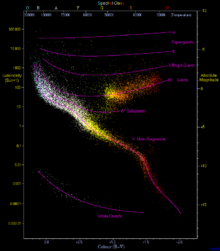HD 114613 ,又名CD-37 8437 ,SAO 204227 、HR 4979 ,是一颗在半人馬座 的次巨星 ,视星等为4.85,位于銀經 307.43,銀緯 24.89。距離地球約67光年,目前已確認有一顆長週期太陽系外行星 存在,並可能還有未發現行星。
HD 114613在赫羅圖 中的位置明顯高於主序帶。 HD 114613位於半人馬座ι 東南方,距離約8角分 處,朝向半人馬座中央。雖然該恆星在夜空中可被肉眼觀測,但因為半人馬座內肉眼可見恆星很多,拜耳天體 和佛蘭斯蒂德天體 目錄並未將它收錄。
HD 114613的B-V色指數和光譜溫度顯示它的光譜類型應是G3,這代表它的表面溫度只比太陽低50 K ,並且外觀呈黃色。在赫羅圖上HD 114613的位置明顯高於主序帶,反而接近次巨星 分支,這代表它核心中的氫已完全耗盡,並且在赫羅圖上移動到巨星分支過程中會增加光度和半徑,但表面溫度降低。因為它在演化過程中溫度降低,代表它在主序星時期的光譜類型屬於較早期類型,可能是接近屬於 F9V 的时钟座ι 。
因為HD 114613即將結束氫融合,它的年齡必定相當古老。根據光譜觀測資料得知其質量1.25 ± 0.03 M☉ 和表面重力log 3.95 ± 0.03 g,可推測出它的年齡為52.0 ± 2.4億年[ 7] 金屬量 原則上隨恆星年齡增加而下降,並且在星系薄盤 內恆星年齡和金屬量範圍極大,所以 HD 114613 的鐵含量高達0.19 ± 0.01 dex(太陽的155 ± 4%)是正常的。而巨大行星在 Fe/H = 0.2 dex 的恆星旁形成的機率是15%[ 11]
HD 114613的特殊之處在於它的光譜型比太陽更加早期,並且現在是次巨星。而它也有一個磁場改變的週期[ 9] 太陽週期 短4.5倍,是已知最短的其中一個恆星磁場改變週期。
因為HD 114613較明亮,並且與太陽類似,天文學家將它列為以徑向速度 法搜尋系外行星的目標。
HD 114613是在南半球自1992年到1998年間進行的 ESO -CES 巡天中首批以徑向速度法進行偵測系外行星的37顆恆星其中一顆[ 12] 高精度徑向速度行星搜索器 (HARPS)對前述恆星進行更進一步觀測,結果認為在距離恆星超過約5天文單位的距離沒有質量相當於木星的行星存在[ 13]
1998年起HD 114613就是 ESO-CORALIE [ 11] AAT -UCLES[ 14] [ 8] [ 15] [ 16] Keck -HIRES Eta-Earth 低質量行星巡天計畫的主要目標,但自2004年起也納入該計畫觀測對象[ 17]
Robert Wittenmyer 等人於2012年發表論文指出[ 18] 天文与天体物理学报 》,但直到2013年才正式出版的論文[ 19] 天倉五 和HD 114613的活動分布指數類似。並且截至2014年1月仍無論文宣稱在HD 114613周圍發現「低質量行星」。
不過,前述研究結果並不表示HD 114613周圍並無任何行星。Wittenmyer 等人於2014年宣稱發現HD 114613存在週期10.5年的徑向速度變化,代表它有一個長週期天體環繞[ 20] 軌道離心率 0.25,代表在寬鬆定義上它是類木星行星。波江座40b _ HD20794c _HD85512b_HD 114613b 偽陽性訊號
^ SIMBAD 的資料是G3V。該恆星光度明顯高於典型主序星應有的光度。在赫羅圖上它的位置應是在次巨星。
^ 1.0 1.1 1.2 1.3 1.4 1.5 Pulsating variable Star . SIMBAD. Centre de Données astronomiques de Strasbourg. [2012-07-13 ] . ^ 2.0 2.1 2.2 2.3 2.4 2.5 VizieR Detailed Page . [2012-07-13 ] . (原始内容存档 于2016-03-05). ^ 3.0 3.1 3.2 3.3 3.4 van Leeuwen, F. Validation of the new Hipparcos reduction . Astronomy and Astrophysics. 2007, 474 (2): 653–664 [2014-02-12 ] . Bibcode:2007A&A...474..653V arXiv:0708.1752 doi:10.1051/0004-6361:20078357 原始内容 存档于2016-04-02). ^ 4.0 4.1 Høg, E.; et al. The Tycho-2 catalogue of the 2.5 million brightest stars. Astronomy and Astrophysics. 2000, 355 : 27–30. Bibcode:2000A&A...355L..27H ^ A Modern Mean Stellar Color and Effective Temperatures (Teff) # Sequence for O9V-Y0V Dwarf Stars (页面存档备份 ,存于互联网档案馆 ), E. Mamajek, 2011, website^ 絕對星等的計算式:
M
=
m
−
5
log
10
(
100
p
a
r
a
l
l
a
x
(
m
a
s
)
)
{\displaystyle \scriptstyle M=m-5\log _{10}\left({\frac {100}{\mathrm {parallax\ (mas)} }}\right)}
M
{\displaystyle M\!\,}
m
{\displaystyle m\!\,}
^ 7.0 7.1 7.2 7.3 Takeda, Genya; et al. Structure and Evolution of Nearby Stars with Planets. II. Physical Properties of ~1000 Cool Stars from the SPOCS Catalog. The Astrophysical Journal Supplement Series. 2007, 168 (2): 297–318. Bibcode:2007ApJS..168..297T arXiv:astro-ph/0607235 doi:10.1086/509763 ^ 8.0 8.1 8.2 8.3 8.4 Sousa, S. G.; et al. Spectroscopic parameters for 451 stars in the HARPS GTO planet search program. Stellar [Fe/H] and the frequency of exo-Neptunes. Astronomy and Astrophysics. August 2008, 487 (1): 373–381. Bibcode:2008A&A...487..373S arXiv:0805.4826 doi:10.1051/0004-6361:200809698 ^ 9.0 9.1 Lovis, C.; et al. The HARPS search for southern extra-solar planets. XXXI. Magnetic activity cycles in solar-type stars: statistics and impact on precise radial velocities. Astronomy and Astrophysics (submitted). 2011. arXiv:1107.5325 ^ Valenti, J. A.; Fischer, D. A. Spectroscopic Properties of Cool Stars (SPOCS). I. 1040 F, G, and K Dwarfs from Keck, Lick, and AAT Planet Search Programs. The Astrophysical Journal Supplement Series. 2005, 159 (1): 141–166. Bibcode:2005ApJS..159..141V doi:10.1086/430500 ^ 11.0 11.1 Mortier, A.; et al. On the functional form of the metallicity-giant planet correlation. Astronomy & Astrophysics. 2013, 551 . Bibcode:2013A&A...551A.112M arXiv:1302.1851 doi:10.1051/0004-6361/201220707 ^ Endl, M.; et al. The planet search program at the ESO Coudé Echelle spectrometer. III. The complete Long Camera survey results. Astronomy & Astrophysics. 2002, 392 : 671–690. Bibcode:2002A&A...392..671E arXiv:astro-ph/0207512 doi:10.1051/0004-6361:20020937 ^ Zechmeister, M.; et al. The planet search programme at the ESO CES and HARPS. IV. The search for Jupiter analogues around solar-like stars. Astronomy & Astrophysics. 2013, 592 . Bibcode:2013A&A...552A..78Z arXiv:1211.7263 doi:10.1051/0004-6361/201116551 ^ Jones, Hugh R. A.; et al. Extrasolar planets around HD 196050, HD 216437 and HD 160691. Monthly Notices of the Royal Astronomical Society. 2002, 337 (4): 1170–1178. Bibcode:2002MNRAS.337.1170J arXiv:astro-ph/0206216 doi:10.1046/j.1365-8711.2002.05787.x ^ Wittenmyer, Robert A.; et al. The Frequency of Low-mass Exoplanets. II. The "Period Valley" . The Astrophysical Journal. 2010, 722 (2). Bibcode:2010ApJ...722.1854W arXiv:1008.5232 doi:10.1088/0004-637X/722/2/1854 ^ Wittenmyer, Robert A.; et al. The Frequency of Low-mass Exoplanets. III. Toward η⊕ at Short Periods. The Astrophysical Journal. 2011, 738 (1). Bibcode:2011ApJ...738...81W arXiv:1103.4186 doi:10.1088/0004-637X/738/1/81 ^ Howard, Andrew A.; et al. The Occurrence and Mass Distribution of Close-in Super-Earths, Neptunes, and Jupiters. Science. 2010, 330 . Bibcode:2010Sci...330..653H arXiv:1011.0143 doi:10.1126/science.1194854 ^ Wittenmyer, Robert A.; et al. The Anglo-Australian Planet Search. XXII. Two New Multi-planet Systems. The Astrophysical Journal. 2012, 753 (2). 169. Bibcode:2012ApJ...753..169W arXiv:1205.2765 doi:10.1088/0004-637X/753/2/169 ^ Tuomi, M.; et al. Signals embedded in the radial velocity noise. Periodic variations in the τ Ceti velocities. Astronomy & Astrophysics. 2013, 551 . Bibcode:2013A&A...551A..79T arXiv:1212.4277 doi:10.1051/0004-6361/201220509 ^ 20.0 20.1 Wittenmyer, Robert A.; et al. The Anglo-Australian Planet Search. XXIII. Two New Jupiter Analogs. The Astrophysical Journal. 2014. arXiv:1401.5525




